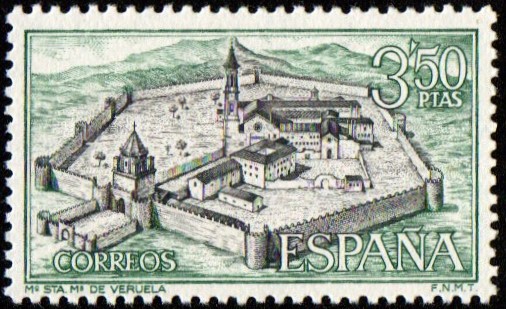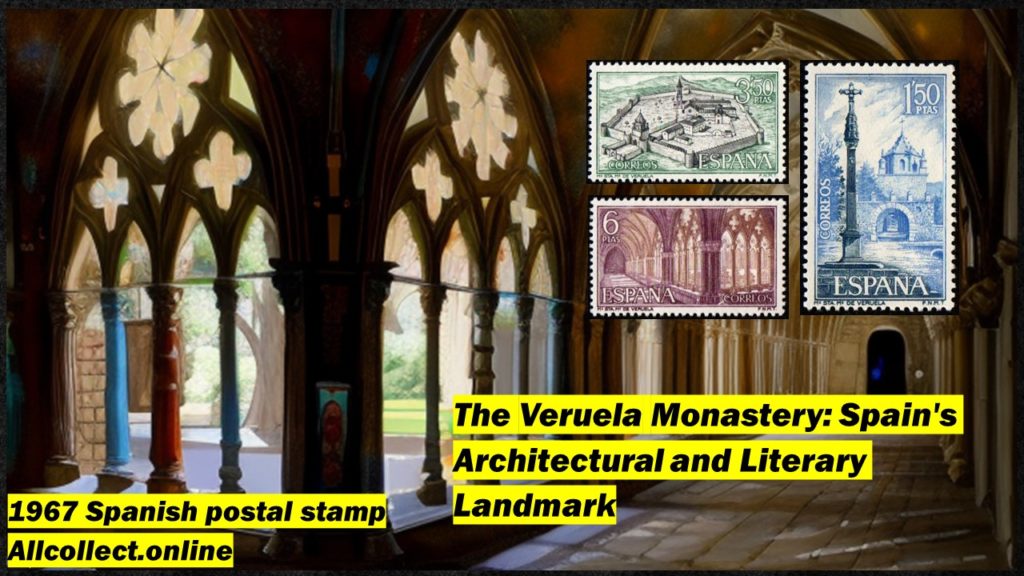In 1967 as part of its traditional series dedicated to Monasteries, Spain issued 8 million copies of each of three postage stamps featuring the Veruela Monastery, depicting the main Entrance to the Monastery, an aerial view, and cloisters.
The Veruela Monastery (Monasterio de Veruela) is located in the province of Zaragoza, in the Aragón region of Spain. This historic monastery, founded in the 12th century, is famous for several reasons:

- Architectural Importance: The monastery is a significant example of Cistercian architecture in Spain. It consists of a mix of Romanesque, Gothic, and Renaissance styles, which are reflected in its cloister, church, chapter house, and other structures.
- Connection to the Bécquer Brothers: The Spanish Romantic poet Gustavo Adolfo Bécquer and his brother, the painter Valeriano Bécquer, spent an extended period at the monastery. It was during this time that Gustavo Adolfo Bécquer wrote many of his “Letters from my Cell” (“Cartas desde mi celda”), a series of nine letters that describe his experiences and observations during his stay at Veruela. These writings are among his most celebrated prose works and provide a vivid account of life in and around the monastery.
- Wine Production: The region surrounding the monastery, known as the Moncayo area, is renowned for its wine production. Historically, the monks at Veruela were known to cultivate vineyards and produce wine.
- Tourism: Today, the Veruela Monastery is a popular tourist attraction. Visitors are drawn to its historic architecture, the serene natural surroundings, and its connection to Spanish literary and artistic history.
- Natural Setting: The monastery is situated at the base of the Moncayo mountain range, providing a picturesque backdrop. The natural beauty of the area, combined with the historic significance of the monastery, makes it a sought-after destination for both nature enthusiasts and history buffs.

Cistercian architecture refers to the architectural style of Cistercian monasteries, which were built by the Cistercian order of monks and nuns, beginning in the 12th century. The Cistercians, a reformist branch of the Benedictines, sought a return to a simpler and more austere way of monastic life. This philosophy was reflected in the design and construction of their monastic buildings. Here are some key characteristics and features of Cistercian architecture:

- Simplicity and Functionality: Cistercian architecture is known for its simplicity and lack of superfluous decoration. The emphasis was on functional and utilitarian designs that met the monks’ needs without distraction.
- Lack of Ornamentation: Unlike other contemporary religious buildings that often featured elaborate sculptures, stained glass, and intricate details, Cistercian buildings were largely devoid of such decorative elements. The absence of decoration was intentional, reflecting the order’s desire for a life of simplicity and humility.
- Clear Floor Plans: The layout of Cistercian monasteries was logical and clear. Typically, they featured a church, a cloister (an open quadrangle surrounded by covered walkways), a chapter house (where monks met daily), a dormitory, a refectory (dining hall), and work buildings like a scriptorium or workshops.
- Use of Local Materials: Cistercians often used local building materials, such as stone, which not only kept costs down but also gave their buildings a harmonious relationship with the surrounding landscape.
- Positioning: Cistercian monasteries were usually located in remote valleys, away from towns and cities. This was in line with their desire for solitude and contemplation. The monasteries were often self-sufficient, with their own mills, gardens, and other necessary facilities.
- Influence of Romanesque and Gothic Styles: While Cistercian architecture is distinct in its austerity, it was also influenced by prevailing architectural trends. Early Cistercian buildings often displayed Romanesque features, such as rounded arches and massive walls. Later structures incorporated Gothic elements, like pointed arches and ribbed vaults.
- Harmony with Nature: Cistercian monasteries were often designed to harmonize with the surrounding landscape. The placement of buildings, gardens, and water features was done in a way that it seemed like a natural extension of the environment.
A new video on our sister channel “Stampscape, the world in miniature”:
#VeruelaMonastery, #SpanishHeritage, #CistercianArchitecture, #BécquerLegacy, #MonasticTraditions, #SpanishLiterature, #HistoricalLandmarks, #ArchitecturalMarvels, #PostageStamps, #AragónRegion

